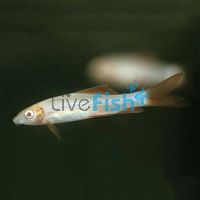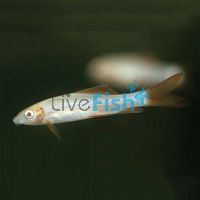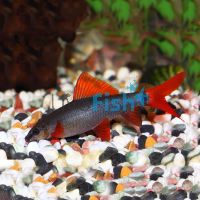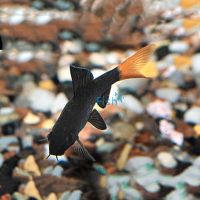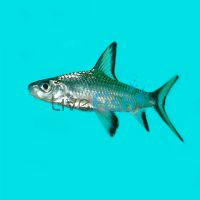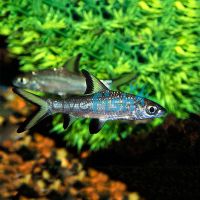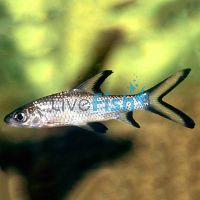Different species of ‘shark’ vary wildly in size, shape and temperament, meaning you should be able to find a species that suits your experience and tank size below. Just be sure to read on and research the proper individual requirements before committing to any particular species.
Shark Care
You will need to consider many factors before deciding on which species of shark is right for your aquarium. Each species has its own benefits and challenges involved, so please be sure to research each individual species’ requirements before purchasing. Our most popular shark species include the Silver (Bala) Shark, Red Tailed Shark, Rainbow Shark, Black Shark and Siamese Flying Fox(Siamese algae eater). In this guide, we will discuss the basic requirements and benefits of each.
Natural Habitat
Freshwater sharks hail almost exclusively from South East Asia, particularly Thailand and Malaysia. Unfortunately, most species have been rendered either critically endangered or functionally extinct in the wild, so the aquarist hobby has actually managed to save a couple of species from total extinction. Most species enjoy clean forest rivers, dams and basins.

Behavior/Compatibility for Sharks
This is the most varied category when it comes to shark species’ care. Beginning with the most popular species, the Silver (Bala) Shark, is a relatively friendly shoaling fish that gets along well with most reasonably peaceful freshwater fish. However, they are capable of fin-nipping behaviours, so you should avoid mixing with small, timid long-finned species. Some great tankmates include Angelfish, medium Barbs, Rainbowfish, Rasboras and Gouramis. Clown loaches are a particularly well-fitting playmate for Silver sharks. Keep in mind that as a shoaling fish, Silver sharks should be kept in groups of at least five. They require a lot of space to roam and grow up to 35 cm (14”), so you will need a large tank to house these (360 litre/80 gallon).
Siamese Flying Fox (Siamese algae eater) have a more placid temperament compared to the Silver (Bala) shark. They are perfectly happy being housed as individuals or in small groups, though most in the group should be females. Some great tankmates include Angelfish, small Barbs, Corydoras and Danios.
Moving on to the moodier species, Rainbow sharks can be territorial and cause dominance issues in community tanks. These traits may appear with maturity, with juveniles usually giving a false impression that they are timid and peaceful fish. Be sure to provide plenty of hiding spaces to reduce aggression and pair them with confident but calm mid-water species like Gouramis, Angelfish, Danios and Rainbow fish. As a general rule, do not house more than one Rainbow Shark in the same aquarium unless you are an expert aquarist.
Red tail black sharks are a close cousin of the Rainbow shark, but families do not always get along. Mixing rainbow and red tails together almost always leads to carnage and should not be attempted. Similarly, red tailed sharks should be kept individually unless you are a professional aquarist. As an aggressive mid-water swimmer, there is a long list of species that are incompatible with Red Tailed sharks, but fortunately, Red Tailed sharks will rarely bite or eat its tankmates. This means that some smaller fish like Tetras will cohabit with your red tail with no major issues. Other compatible species include Gouramis, Angelfish, Danios and Barbs.
Black sharks are the biggest species of freshwater shark, eventually reaching a whopping 91 cm (36”). They are highly aggressive and will battle other black sharks mercilessly. However, despite their size and aggression, they actually do quite well with smaller species, most likely as they aren’t seen as a threat. Mid-water and surface species such as Gouramis, Angelfish, Danios and Barbs tend to be safe as they will be happy to just avoid whichever corner of the substrate your black shark lays claim to. You will of course need a huge tank for these river monsters.
Housing Sharks and Tank Set-up Tips
Tank
This will of course depend on the species of shark you would like to raise. A 91 cm black shark will of course have separate tank sizes to a 15 cm Siamese flying fox. However, as most species are recommended only as individuals, the below tables will be for Siamese flying foxes and silver (bala) sharks only, with the solitary species listed thereafter. Keep in mind that silver (bala) sharks are shoaling fish, and should be kept with a minimum of 5 to a tank.
Recommended Max Fish Count Tank Volume 1-3 Siamese Flying Foxes 94 litres (25 gallons) 5 Siamese Flying Foxes 113 litres (30 gallons) 8 Siamese Flying Foxes 150 litres (40 gallons) 10 Siamese Flying Foxes 190 litres (50 gallons) Recommended Max Fish Count Tank Volume 5 Silver Sharks 300 litres (80 gallons) 8 Silver Sharks 470 litres (123 gallons) 10 Silver Sharks 680 litres (180 gallons) 12 Silver Sharks 1000 litres (280 gallons) Recommended Max Fish Count Tank Volume Red Tail Black Shark 113 litres (30 gallons) Rainbow Shark 190 litres (50 gallons) Juvenile Black Shark 473 litres (125 gallons) Adult Black Shark 757 litres (200 gallons) Base
Sharks tend to be bottom feeders, so a sandy substrate is recommended to avoid injury as they sift through the base of your tank.
Foliage
All freshwater shark species either enjoy or require plenty of hiding spaces to call their own. Be sure to include large rocks, driftwood or caves for this reason. Densely populated plants are recommended, though ample swimming space will be required. Red tail black sharks may chew through leafy plants like amazon swords, but smaller leaf plants like baby tears should be able to better manage similar damage.
Water
Despite their differences, freshwater sharks all hail from similar regions and subsequently have similar water requirements. try to keep the temperature at around 22 to 26 degrees C (71.6 – 78 F). Depending on your local climate, you may need to install a water heater to ensure the temperature stays within this range.
Your Ph should be 6 - 8 and you should aim for a hardness of 5 - 15 DGH. To ensure your pH and hardness are suitable you should invest in a testing kit. Always ensure your water is properly filtered, and regularly change the water (25% weekly or 50% every other week). This is especially important with sharks, who handle wild swings in water conditions poorly.
You should also filter the substrate regularly and adjust the chemistry of any tap water you use to top your tank. You may do this with one of our many water conditioning products.
Sharks are known to jump on occasion, so be sure to include a sturdy lid on your aquarium.
Feeding and Care
Despite the carnivorous image the name and aggression may conjure up, sharks are omnivorous fish that typically feed via scavenging. Most are prolific algae eaters and go a long way towards controlling algae and snail outbreaks in your aquarium. As bottom feeders, you will need to provide high-quality sinking pellets, the occasional sinking vegetable snack and bloodworms, daphnia or insect larvae. Sharks are not fussy eaters, but be sure to feed them around wherever they have taken up residence in your tank.
Great reasons to keep sharks in your tropical fish tank
- Sharks are a great challenge for those that want to take the next step in the fish keeping hobby.
- They are a varied group of fish with a species to fit just about every desire.
- You get to tell your friends you own a shark.
See below for our range of sharks and select one that fits your tank size and experience level. These long-living fish will make a great fish pet for many years.
